Lithium-ion batteries are everywhere. Here's how to manage the fire risk
Lithium-ion batteries are in most consumer electronics, from power banks and smartphones to active mobility devices. Although fires arising from the use of these batteries are not commonplace, experts warned that people should take precautions.
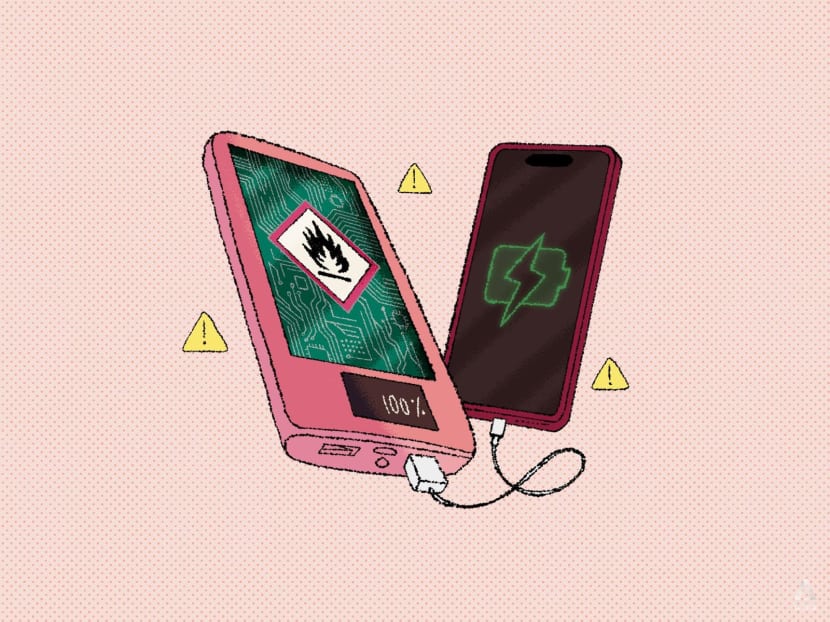
Singapore has seen an increase in fires involving lithium-ion battery products such as power banks and active mobility devices in the last few years. (Illustration: CNA/Nurjannah Suhaimi)

This audio is generated by an AI tool.
Rushing out of the house on Jun 22 at about 2.30pm, 19-year-old Sophie did not think twice about leaving her portable power bank charging on her bed.
The power bank – a door gift from a school reunion party in 2022 – had been working well just weeks earlier during a trip to Japan. Apart from minor scratches due to wear and tear, nothing else seemed amiss.
Ms Sophie, who is preparing for her A-Level examinations and declined to make public her last name for privacy reasons, had placed the power bank on the bed to avoid making it a tripping hazard on the floor.
So it came as a shock when later that day, at around 9.40pm, her family called and told her that a fire had started in the bedroom she shared with her older sister.
"My younger brother had walked by my room to take a shower when he noticed black smoke coming from the top and bottom of the door," the teenager said.
"The power bank had exploded."
Ms Sophie and her older sister were not home at the time but the rest of their family members were. They used a fire extinguisher to put out the fire, then dialled 995 as the room continued to smoulder.
The Singapore Civil Defence Force (SCDF) eventually extinguished the fire.
"The whole room was matte black – everything was covered in soot," she said of the aftermath.
"We had to call contractors to remove the soot, clean the room professionally and fix up all the wires. We still don’t have an air conditioner since it melted. That will come sometime this week."
The flames engulfed her bed, most of her wardrobe and the plastic lid of her record player, among other belongings.
Since the incident, Ms Sophie and her family have been more vigilant about charging their electronic devices.
"I don’t think I can ever own a power bank after this incident," she told CNA TODAY on Jul 8.
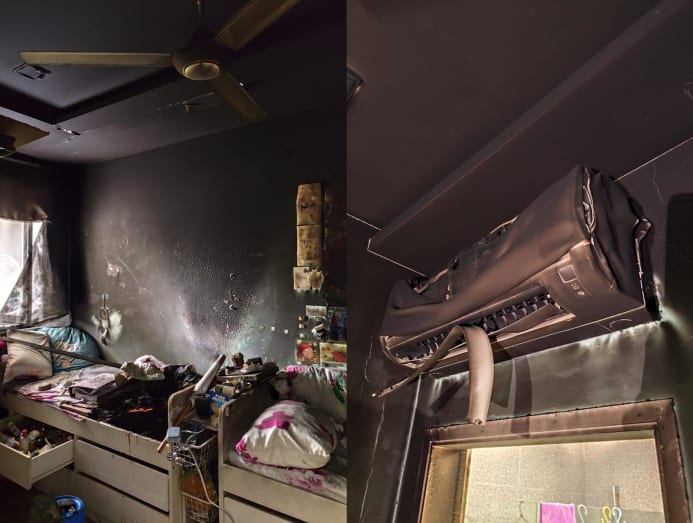
A quick scan of news headlines shows her experience is definitely not an isolated case. Chinese newspaper Shin Min Daily News reported that a power bank exploded while it was charging on Jul 5 at about 11am, in a four-room flat at Block 339B Kang Ching Road in Jurong West.
In response to queries from CNA TODAY, SCDF said reported power-bank fires have risen from just six in 2020 to 13 in 2024.
Moreover, fires involving active mobility devices such as personal mobility devices (PMDs), personal mobility aids and power-assisted bicycles continue to increase.
SCDF received 67 calls for fires involving active mobility devices last year, a 21.8 per cent increase from the 55 calls in 2023.
The rise in such fires here, along with other high-profile battery fire incidents globally, has cast a spotlight on the risks associated with lithium-ion battery products, which pack a powerful punch for their size.
Growing safety concerns have prompted regulators and airlines worldwide to tighten regulations on their use.
In February this year, a burning power bank filled a plane with smoke – a Batik Air flight from Johor Bahru, Malaysia, to Bangkok, Thailand – and this was just one of several mid-flight incidents involving power banks in recent months.
As a result, several airlines, including Singapore Airlines and Scoot, now ban the use and charging of power banks on flights.
More recently, the Civil Aviation Administration of China said power banks can be taken on board domestic flights within China only if they are clearly marked with the official China Compulsory Certification logo. Power banks that have faded or illegible labels of the certification or are part of a product recall will also be barred.
E-scooters and e-bikes are also banned on public transport in some countries, such as the United Kingdom, over concerns about fire risks.
Battery fires can break out for various reasons such as overcharging and manufacturing defects, experts told CNA TODAY.
However, considering the sheer number of consumer electronics – from power banks, smartphones and laptops to power-assisted bicycles and PMDs – the experts noted that serious incidents are extremely rare relative to the number of devices.
LIGHTWEIGHT, HEAVY-DUTY
Lithium-ion batteries are rechargeable batteries that store and release energy when a liquid or gel moves lithium ions between electrodes within the battery cell.
Dr Denice Durrant, director of engineering and data science at UL Standards & Engagement (ULSE), a global safety organisation based in the United States, said: "They are impressively efficient and long-lasting, which is why they increasingly power many of the devices we rely on daily, including smartphones, power banks and electric vehicles."
However, the batteries can catch fire. Apart from overcharging and manufacturing defects, other reasons include overheating, short-circuiting and physical or mechanical damage.
Exposure to high temperatures and a phenomenon known as thermal runaway can also spark a fire.
Thermal runaway occurs when an electrochemical cell's temperature rises uncontrollably due to self-heating, continuing to release electricity as it produces heat faster than it can cool down.
Because lithium-ion cells are densely packed in a battery, this heat can spread to adjacent cells, triggering a chain reaction. The result can be a rapid increase in temperature across the battery pack, potentially leading to smoke, fire or even explosions.
Dr Sheikh Mohamed Anees, a senior forensic scientist at the Home Team Science and Technology Agency (HTX), said that batteries undergo wear and tear through repeated charging and discharging cycles over time.
"This can lead to internal defects, increasing the likelihood of thermal runaway. A common indicator of ageing is battery bloating – though this is not the only warning sign."
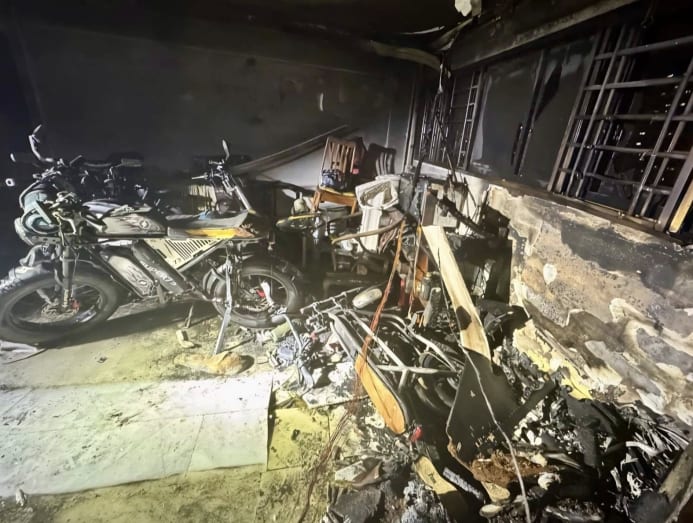
Another expert said that there are other challenges and risks when putting out a fire involving a lithium-ion battery.
Assistant Professor Hung Dinh Nguyen from the School of Electrical & Electronic Engineering at Nanyang Technological University (NTU) said: "The fire in a lithium battery is difficult to put out.
"Lithium batteries burn at very high temperatures; for instance, flame temperatures as high as 1,500°C have been reported in battery modules."
Beyond that, the fire can self-sustain in sealed battery packs, so the battery may continue burning even after the outer flames are extinguished.
"What is more, the flame could reignite in the battery module due to residual thermal energy and ongoing chemical reactions," Asst Prof Nguyen added.
"Lithium battery fires also release toxic gases such as carbon monoxide, therefore extreme caution should be taken when trying to handle the fire."
Experts told CNA TODAY that the risk of fires can also differ across products and battery sizes.
Power Banks
Assistant Professor Dhivya Sampath Kumar from the Singapore Institute of Technology (SIT) said that portable chargers often lack sophisticated safety features found in more integrated systems such as PMDs or smartphones. These typically have integrated battery management systems with multiple layers of cell protection, temperature sensors and firmware-level battery diagnostics.
A battery management system tracks the voltage of the battery and prevents the charging voltage from exceeding the maximum charging voltage to avoid overcharging.
"Smartphones and PMDs are designed as complete systems, with battery safety embedded into both their hardware and software, which includes thermal throttling, adaptive charging algorithms, and protection coordinated through the device's main processor," Asst Prof Sampath Kumar added.
"(In contrast), power banks are standalone charging devices with off-the-shelf battery cells and basic protection boards. While reputable brands implement protections like overcharge, short-circuit and over-discharge cutoffs, cheaper models may lack these or use substandard components, increasing fire risk."
Asst Prof Sampath Kumar also said that power banks with fast-charging features and higher mAh ratings – the measure of a battery’s electrical charge capacity – can introduce added risks, especially when not paired with adequate safety components.
"Fast charging involves pushing higher current or voltage through the battery in a shorter time. This creates increased heat within the battery cells and within the charging circuitry.
"If the power bank lacks effective thermal management, accurate current regulation or a well-calibrated battery management system, the device can overheat, degrade faster or undergo thermal runaway, especially under extreme temperatures," she added.
High-capacity power banks, which typically are 20,000mAh and above, contain a larger number of lithium-ion cells. This means they have a longer battery life, but it comes with a higher risk of internal imbalance and cell-level failures.
"Poor-quality, high-capacity banks might use refurbished cells, mismatched cell groups or skip protection circuits to cut costs, increasing the risk factors," she cautioned.
Active Mobility Devices
Fires originating from active mobility devices can be caused by the same factors as those in power banks, for example, manufacturing defects and physical damage.
However, with these devices, illegal modification can also increase the risk of fires. Some people tinker with the batteries to lighten the device’s weight and increase the battery’s capacity.
Such changes can bump up the device’s speed and charge time but they come with a risk.
Mr Low Choon Chye, vice-president of Service Quality Centre, a subsidiary of the Management Development Institute of Singapore (MDIS), said: "There are many considerations in place, like the current and specification requirements of electrical components.
"If you were to change some of the components, it might lead to incompatibility and a surge in current in some cases."
The Land Transport Authority (LTA) and SCDF said in a joint statement last year that 60 per cent of fires from active mobility devices in 2023 resulted from illegally modified devices, typically caused by an "electrical anomaly in their battery".
"Investigations conducted by SCDF and LTA showed that most fires related to active mobility devices were caused by modifications to the device electrical circuitry by using non-original parts or installation of additional batteries."
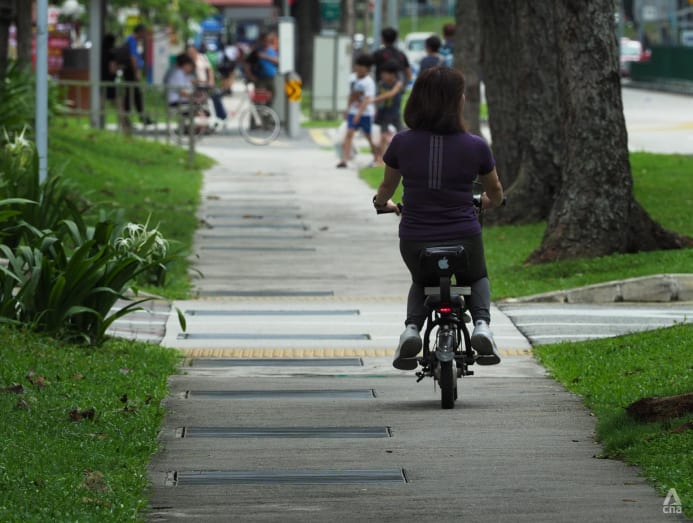
Electric Vehicles
Experts said that fires from electric vehicles (EVs) are rare globally, noting that there are strict regulations around EV batteries.
These e-vehicles also often come with layers of built-in protection systems such as advanced cooling systems and cell spacers, which significantly reduce the likelihood of fires, Dr Sheikh of HTX said.
In Singapore, SCDF said that it responded last year to 215 fires involving internal combustion engines and EVs. Of these, only one involved an EV.
Between 2020 and 2024, SCDF responded to five EV fires. In contrast, it responded to 928 internal combustion engine vehicle fires.
"Notwithstanding the relatively low number of EV fires at present, SCDF is aware and prepared for the unique challenges such as the risk of a thermal runaway involving the high-voltage battery," it said in response to CNA TODAY’s queries.
Every vehicle should be equipped with a dry powder fire extinguisher, which can be used to put out a small fire before it spreads or grows larger, it added.
"If you detect a fire and have a fire extinguisher with you, you may attempt to extinguish the vehicle fire while it is still small or safe to do so. Otherwise, call 995 for SCDF’s assistance.
"However, if you notice signs of a battery fire involving an EV, do not attempt to extinguish the fire and instead call 995 for SCDF’s assistance."
HIGHLY REGULATED SPACE
Despite the well-documented risks, lithium-ion batteries remain the top choice for consumer products since there are no alternatives just yet, experts said.
Other existing alternatives, such as lead-acid and nickel-cadmium batteries, have low energy densities and therefore cannot store as much energy in the same amount of space.
"Their usage is limited to power grid applications and as backup power supplies," Asst Prof Nguyen from NTU said.
Since lithium is a rather rare metal, researchers are developing new batteries based on sodium and potassium. The research is promising, he added, but further development is needed before these can compete with lithium-ion batteries.
Although concerns about lithium-ion batteries are valid, the batteries are safe and their risks are manageable, the experts said.
"Lithium-ion batteries can be dangerous if mishandled or poorly made," Dr Durrant of ULSE cautioned, saying that this was exactly why ULSE develops battery safety standards and works to further public education around these devices.
"If battery-powered products are built in accordance with high safety standards and used properly, the likelihood of an incident is very low," she added.
Mr Low from the Service Quality Centre said that one recognised safety standard is the UL2054, which requires batteries in household and commercial applications to undergo rigorous testing under abuse conditions such as short-circuiting, overcharging, dropping and crushing.
This is often required for products sold in North America.
There is also the UN38.3, a mandatory transportation safety standard for lithium batteries, established by the United Nations.
"It applies to all lithium-ion and lithium-metal cells and battery packs shipped by air, sea or land … and it is required by international shipping regulations to prevent incidents during transit," Mr Low said.
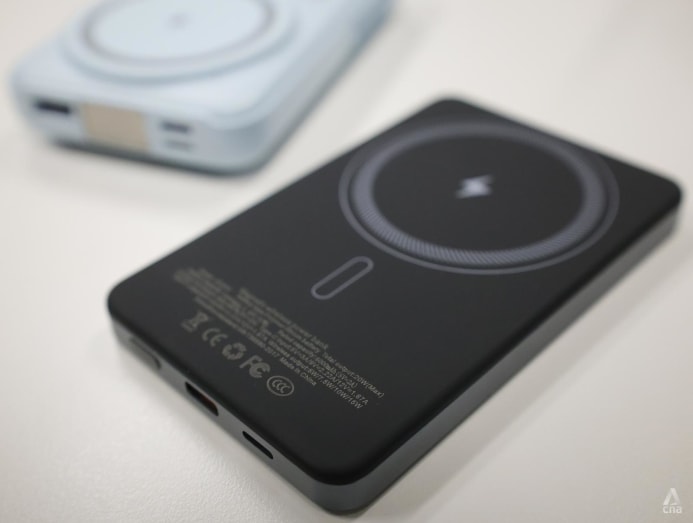
In Singapore, several organisations also enforce safety labelling and testing for these batteries.
The Competition and Consumer Commission of Singapore (CCCS) told CNA TODAY that the Consumer Product Safety Office (CPSO) administers the Consumer Protection (Consumer Goods Safety Requirements) Regulations.
Under this regulation, suppliers are responsible for ensuring that general consumer goods, including power banks, or other consumer electronics containing lithium-ion batteries, comply with applicable safety standards before they can be sold here.
CPSO also conducts "proactive market surveillance to identify unsafe consumer goods being sold in the market and may require suppliers of non-compliant products to cease supply", CCCS said.
In 2022, two out of five tested power bank models were found to be non-compliant with international standards and their suppliers were directed to stop the supply of the products.
The office then tested 13 power bank models in 2024 and all were found to be compliant with international standards.
"Since 2022, the CPSO has investigated several incidents involving battery-powered products, including power banks and other consumer electronics.
"CPSO engaged the suppliers in these cases and verified that products complied with applicable safety standards," CCCS said.
LTA also regulates the use of active mobility devices in Singapore. Among its requirements, PMDs must be certified under the UL2272 fire safety standard, which ensures that the battery can withstand extreme physical conditions.
On Jan 23 this year, a retailer was charged when caught selling a non-compliant battery and an illegally modified power-assisted bicycle, which were both linked to fires in April 2024.
This was Singapore's first such prosecution. The retailer, 29-year-old Prince Bryan Tan, was ordered to pay a S$7,000 fine.
Dr Sheikh of HTX said these standards are reviewed and recommended by inter-agency task forces comprising experts from the public and private sectors, regulators and stakeholders.
These standards are constantly reviewed and updated based on international best practices and domestic research findings before eventual adoption.
He added that the agency conducts research on improving capabilities in preventing and mitigating battery fires, for example, by improving infrastructure such as sprinklers and misting systems.
HTX is also a co-founder of the Association of Southeast Asian Nations (ASEAN) Battery Safety Network, which aims to establish and improve regional battery safety standards and best practices, Dr Sheikh said.
Even with the best efforts and more stringent regulations, it is not possible to fully extinguish battery fires, the experts said.
Mr Low from the Service Quality Centre said that although manufacturers do their own testing, faulty products may still end up in consumers’ hands.
"Even when sent for testing, (manufacturers) don’t send an entire batch of products to be individually tested," he added. "There’s always a confidence level that the products will be safe based on probability."

Beyond that, there is also user error.
"Physical damage can cause a short circuit. Battery cells are separated by separators, often made of plastic. So, for example, if you drop (the battery), you could damage that, causing a short circuit," Mr Low explained.
Asst Prof Sampath Kumar from SIT said that online marketplaces and unverified imports pose regulatory challenges because it is difficult for the authorities to keep track of every power bank purchase to ensure compliance.
"Moreover, the diverse nature of the power banks with varying capacities and technologies makes consistent monitoring a big challenge," she added.
"Many cheap online models don’t declare their certifications and the average buyer might not be aware of their safety risks."
KEEPING PEOPLE SAFE WHEN USING LITHIUM-ION BATTERIES
Since it is nearly impossible to avoid lithium-ion products due to their widespread use, consumers can take some steps to reduce the risk of fire.
They should buy lithium-ion battery products from trusted retailers, ensure the goods are not subject to any recalls and check that the charger or adapter carries a valid SAFETY mark registered with the CPSO, the experts and authorities said.
Since batteries are exposed to wear and tear over time, the experts also cautioned against buying second-hand products.
Active mobility devices are required to meet regulatory requirements and testing before being imported and used in Singapore. People looking to buy such devices should check with retailers that they have met testing requirements and standards.
CCCS told CNA TODAY that after purchasing the products or devices, consumers should also take precautions when using or charging a battery product:
- Use only the manufacturer-recommended chargers and batteries
- Follow the device’s charging instructions carefully
- Monitor while charging and unplug when fully charged
- Never charge the product in areas with restricted airflow such as under pillows or on bedding
- Keep devices and batteries away from heat sources and moisture
Electronic devices should not be charged overnight and unattended, the experts cautioned.
Users should also be careful not to charge their devices with fast chargers that have a higher electrical output than what their device can handle.
And watch out for tell-tale signs that a lithium-ion battery product should not be used, which include:
- Bloated or swollen batteries
- Chemical leakage
- Excessive heat during charging
- Unusual odours
- Physical damage
CCCS said that should these warning signs appear, consumers should stop using the device and contact the authorised distributor or service provider for assistance.
Such devices should also be disposed of carefully at an e-waste collection point.
CNA TODAY visited 10 homes where fires from active mobility devices had taken place in the last three years across Singapore between Jul 8 and 10. Four homeowners had moved out, while the others were not at home or declined to comment.
Their neighbours, though, have changed their perspective on lithium-ion batteries following the fires. They said they were more cautious around PMDs and do not leave their electronic devices charging overnight and unattended.
As for Ms Sophie, two weeks spent sleeping in the living room and having to renovate her bedroom and replace her belongings have left her fearful of power banks.
"I went out with some friends and my phone battery was dying but I didn’t have a power bank on me. I had to borrow my friend’s," she said.
"I really don’t think I can have a power bank again after this incident."
Additional reporting by Saw Yone Yone and Ooi Boon Keong.












